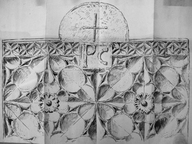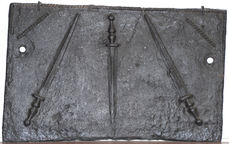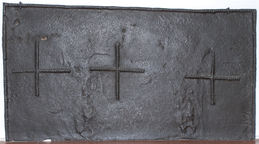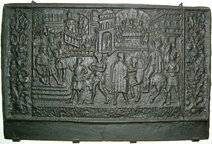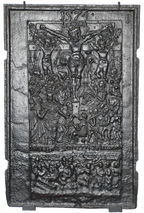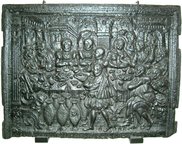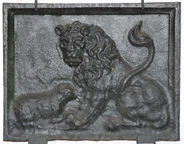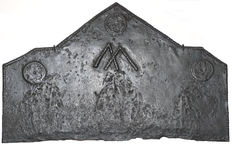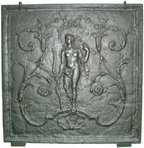-
1083
Description: Arched rectangular shape; fillet edging (top and sides); twisted rope cross in centre of arch; fillet-edged square below arch containing initials of uneven size; along the top, a line of five quatrefoils on each side of the initials; below, two symmetrically carved roundels and associated spandrels, each with a central flower.
Notes: The quatrefoils and roundels are likely to have been part of a redundant, probably medieval, furniture panel, perhaps from a chest. The life-size rubbing, reinforced with ink, is by W. R. Lethaby. The fireback was formerly property of the artist John Callcott Horsley RA (1817-1903) at Wilsley Green, Cranbrook, Kent.
Inscription: PC
- Decoration tags:
- arched rectangular (shape)
- fillet (edging)
- carved pattern panels
- apotropaic
- text
- objects
Manufactured: in the mid to late 16th century possibly in the Weald area of England.
Current location: Victoria & Albert Museum, Cromwell Road, Kensington & Chelsea, London, England.
Museum number: 3267-1932 (part of the Victoria & Albert Museum museum group)
Citation: Lethaby, W. R., 1 Oct 1926, 'English Cast Iron - I', The Builder, 131, no. 4365, pp. 537-8.
- Attached to series:
- Miscellaneous pattern firebacks
-
726
Description: Arched rectangular central panel with bead-on-fillet edging; pictorisl scene of a central cross-shaped pillar entwined with a snake; two pavilions to the left with human figures lying before them; two standing figures to the right, one holding a staff; above, clouds with snakes descending from the sky; arched rectangular border with fillet edging; on each side, descending festoons of fruit entwined with ribbon; at the bottom, a central cartouche between palm fronds; on top, foliate swirls.
Notes: The scene is an illustration of the plague of serpents visited upon the children of Israel by God (Numbers 21: 6).
Copies of this fireback are known.
Manufactured: in the mid 17th century possibly in the Siegerland area of Germany.
Current location: Victoria & Albert Museum, Cromwell Road, Kensington & Chelsea, Greater London, England.
Museum number: 291-1893 (part of the Victoria & Albert Museum museum group)
Citation: Anon., 2 Dec 1905, 'Old Kent and Sussex Fire-backs', Country Life, pp. 767-768.
- Attached to series:
- 'Dutch' Miscellaneous Firebacks
- Old Testament & Apocrypha firebacks
-
727
Description: Rectangular; twisted rope edging (top and sides); canted rope lengths across top corners; three impressions of a rondel dagger (c. 410mm) with a baluster-turned grip, the middle one per fess, pommel in chief, the other two on either side, per bend, points in chief.
Notes: The arrangement of daggers is similar to the arms of Vigures, of Launceston, Cornwall, but inverted; the plate has been pierced on each side for fixing to the back of the fireplace; the dagger (length approx. 41cm) may be of German design.
- Decoration tags:
- rectangular (shape)
- rope (edging)
- simple stamps
- objects
Manufactured: in the mid to late 16th century possibly in the Weald area of England.
Current location: Victoria & Albert Museum, Cromwell Road, Kensington & Chelsea, Greater London, England.
Museum number: 896.1901 (part of the Victoria & Albert Museum museum group)
- Attached to series:
- Knife & Dagger stamp firebacks
-
728
Description: Quasi-rectangular; twisted rope edging (top and sides); across the centre, three crosses formed of the repeated stamping of a length of twisted rope.
Notes: The edging appears to have been formed of the same length of rope. The crosses almost certainly have Christian significance.
- Decoration tags:
- quasi-rectangular (shape)
- simple stamps
- apotropaic
- objects
Manufactured: in the 16th century possibly in the Weald area of England.
Current location: Victoria & Albert Museum, Cromwell Road, Kensington & Chelsea, Greater London, England.
Museum number: 887.1901 (part of the Victoria & Albert Museum museum group)
- Attached to series:
- Rope design firebacks
-
729
Description: Rectangular; flanged edge; central pictorial panel illustrating Mordecai arriving before King Ahasuerus, Haman hanging from the gallows behind; two floral side panels, at the top of each a monogram within a cartouche: on the left KS, on the right H?D; plain extension panel at bottom.
Notes: Stoveplate; the scene illustrates a scene from Esther 7: 10 and 8: 1.
Copies of this fireback are known.
Inscription: KS H[?]D
- Decoration tags:
- rectangular (shape)
- flanged (edging)
- whole carved pattern
- extension panels
- pictorial
- biblical
- architectural
- text
- animals
- humans
Manufactured: in the late 16th to early 17th century possibly in the Eifel area of Germany.
Current location: Victoria & Albert Museum, Cromwell Road, Kensington & Chelsea, Greater London, England.
Museum number: M.112-1953 (part of the Victoria & Albert Museum museum group)
- Attached to series:
- Stoveplates
- Esther stoveplates
-
730
Description: Rectangular; flanged fillet edging; single date stampo above a pictorial scene showing the cricifixion with members of the Holy family, soldiers and onllokers surrounding the three crosses; kinscription betlow separating a separate pictorial panel illegible through corrosion; a single letter 'I' in top right corner.
Notes: A characteristic stove-plate of the period.
Copies of this fireback are known.
Inscription: 1574 I / INRI / MATTEUS AM 27 CAPITEL
- Decoration tags:
- rectangular (shape)
- flanged (edging)
- whole carved pattern
- individual letters
- pictorial
- biblical
- text
- humans
Manufactured: in 1574 possibly in the Sudeifel area of Germany.
Current location: Victoria & Albert Museum, Cromwell Road, Kensington & Chelsea, Greater London, England.
Museum number: M.126-1914 (part of the Victoria & Albert Museum museum group)
Citation: Anon., 2 Dec 1905, 'Old Kent and Sussex Fire-backs', Country Life, pp. 767-768.
- Attached to series:
- Stoveplates
-
731
Description: Rectangular with flanged edging and a moulded frame; pictorial scene of the Marriage at Cana in an architectural setting; inscription along bottom edge.
Notes: The pattern-maker is believed to be Master Ronnung.
Inscription: HISTORIA VON DER HOCHZEIT ZV CANA IN GALILEA ...
- Decoration tags:
- rectangular (shape)
- flanged (edging)
- whole carved pattern
- pictorial
- biblical
- text
- humans
- objects
Manufactured: in the late 16th century possibly in the Harz area of Germany.
Current location: Victoria & Albert Museum, Cromwell Road, Kensington & Chelsea, Greater London, England.
Museum number: 319.1897 (part of the Victoria & Albert Museum museum group)
Citation: Dawson, C., 1903, 'Sussex Iron Work and Pottery', Sussex Archaeological Collections, 46, pp. 1-54.
Citation: Gardner, J. S., 1898, 'Iron Casting in the Weald', Archaeologia, 56, 1, pp. 133-164.
- Attached to series:
- Stoveplates
- Marriage at Cana stoveplates
-
732
Description: Rectangular; cavetto edging all round; seated lion on right, its tail rising above its back and its head turned to face the viewer; a seated sheep on the left.
Notes: Intended to represent the saying, ‘The lion shall lie down with the lamb’, a popular misquotation of Isaiah 11: 6. Some variants are dated 1679 (see no. 481).
Copies of this fireback are known.
- Decoration tags:
- rectangular (shape)
- cavetto (edging)
- whole carved pattern
- pictorial
- biblical
- animals
Manufactured: in the mid to late 17th century in the Weald area of England.
Current location: Victoria & Albert Museum, Cromwell Road, Kensington & Chelsea, Greater London, England.
Museum number: 894.1901 (part of the Victoria & Albert Museum museum group)
- Attached to series:
- Small cavetto series
- Old Testament & Apocrypha firebacks
-
733
Description: Rectangular with canted top corners and a triangular extension from the top edge; twisted rope edges to all sides except bottom; a circular wafering iron or butter mould stamp, incorporating a square design with a fleur-de-lys on each side, repeated thrice, one at the apex and one below each of the canted corners; two inverted ‘V’ rope shapes overlapping to make an ‘M’ below top stamp.
Notes: The inverted double 'V' may be apotropaic, invoking the protection of the Virgin Mary; the circular stamp has also been noted on a Pelham-associated fireback of 1642 (no. 1204) which may suggest that it was a product of one of the family's ironworks.
- Decoration tags:
- canted rectangle with triangular arch (shape)
- rope (edging)
- simple stamps
- apotropaic
- objects
Manufactured: in the late 16th to early 17th century possibly at Waldron Furnace in the Weald area of England.
Current location: Victoria & Albert Museum, Cromwell Road, Kensington & Chelsea, Greater London, England.
Museum number: 895.1901 (part of the Victoria & Albert Museum museum group)
Citation: Page, S. & Wallace, M. (eds.), 2018, Spellbound (Oxford, Ashmolean Museum), p. 72.
- Attached to series:
- Food mould stamp firebacks
- Rope design firebacks
-
734
Description: Rectangular; wide fillet and cavetto-moulded edging; female figure holding a bow, with a quiver of arrows on her back, standing on a scallop shell; foliate swirls on each side.
Notes: The figure is that of Diana or Artemis.
- Decoration tags:
- rectangular (shape)
- fillet and cavetto (edging)
- whole carved pattern
- pictorial
- mythological
- humans
Manufactured: in the early 18th century in France.
Current location: Victoria & Albert Museum, Cromwell Road, Kensington & Chelsea, Greater London, England.
Museum number: M.114-1929 (part of the Victoria & Albert Museum museum group)
- Attached to series:
- Miscellaneous pattern firebacks
